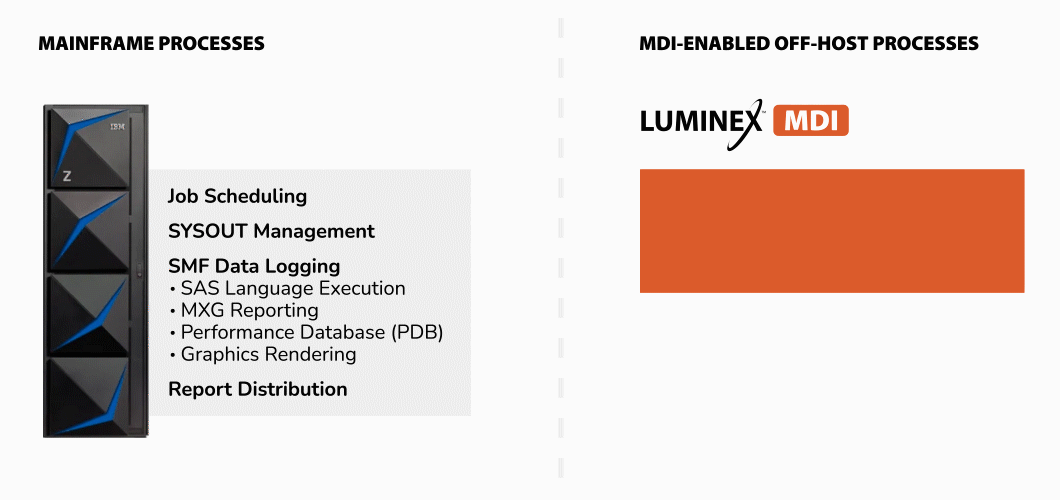National Transportation Provider Moves Reporting for Capacity Planning Off-Host:
Since the 1980s, capacity planners have used Merrill’s Expanded Guide (MXG) by Merrill Consultants to turn raw mainframe System Measurement Facility (SMF) records into detailed reports, insightful graphics and clarifying charts to better understand and manage their mainframe environment. Over the years, MXG has continued to shift much of the burden of day-to-day data management off of capacity planners. As a result, and as SMF record creation evolved and became more detailed, the process of collecting, sorting and storing the huge number of records generated by SMF has, in many cases, become one of the top ten CPU workloads on the mainframe.
This was the case for capacity planners at a leading North American transportation provider. MXG organizes SMF records into formatted SAS data sets, commonly referred to as a Performance Data Base or PDB. Executing their daily jobs to build the PDB regularly consumed 16% of their processor for a period of 6 to 8 hours each day, as the workload was assigned a low-priority and their mainframe applications generate over a terabyte of SMF records per day. Although the MXG workload was scheduled to execute during off-peak hours and, therefore, didn’t affect their Rolling 4 Hour Average (R4HA), the company was eager to use that valuable processor time for other more critical workloads.
The client was also interested in reducing the wall-clock time needed to execute these reports as well as the ability to use aggregated data from both mainframe and distributed systems in enterprise-wide analytics. The sheer size of the data sets and the resulting time required to process meant that adding strategic workloads and achieving better business insights would not be possible without impacting their R4HA or committing to a costly mainframe upgrade.
Challenges
Reporting for mainframe capacity planning was restricting more business-critical jobs.
Solution
- Luminex MDI SLP
- Luminex Professional Services
Benefits
- 99% reduction in MSUs for SMF reporting
- 95% reduction in wall-clock time
- 7 TB reduction in DASD usage
On the Right Track with Luminex MDI SLP:
Luminex’s Mainframe Data Integration (MDI) solutions enable highly efficient, secure and fast off-host data movement and co-processing capabilities for data centers looking to maximize the value of their mainframe data and infrastructure. For MXG processing, Luminex’s MDI SLP provides a mainframe-managed workflow that moves large amounts of raw SMF data over the native FICON channels for off-host MXG processing using the Luminex co-processing platform. The mainframe retains control of scheduling, batch execution of MXG jobs and report distribution without incurring any of the overhead. Nearly all CPU work-load is eliminated for the mainframe and wall-clock times for PDB processing and reporting are greatly reduced from 8 hours to a few minutes.
The Luminex solution is based on the MDI Platform, a FICON-attached appliance that allows SMF and other mainframe data to be moved quickly over FICON, converted from EBCDIC to ASCII on the fly, and into network attached storage (NAS). SLP uses JCL parameters sent by the mainframe to trigger MXG processing on a Linux server in the client’s environment. The ASCII version of MXG, available at no additional cost to existing MXG clients, completes PDB and reporting processes using an existing, or new, SAS Institute license for Linux. Once processing is complete, reports can be distributed back to the mainframe, or anywhere else, according to the mainframe job’s instructions.

Professional Services
Luminex Professional Services simplifies the implementation and modernizes SAS language code, making it more efficient and easier to manage. Much of the existing code base for SMF processing can be optimized with MXG, replacing hundreds of lines of JCL and SAS language code with minimal lines of MXG macros. Obsolete and patchwork code from over the decades and retired authors, along with unused licensed libraries can be eliminated, creating a clean slate for future reporting projects.
Results and Benefits:
After implementing Luminex MDI SLP, the client’s wall-clock time for daily PDB and report processing was reduced from 6-8 hours on the mainframe down to 26 minutes using the Luminex solution. By offloading SMF and PDB data storage and the execution of MXG jobs to the Luminex environment, the client reclaimed 7 TB of production DASD space and reduced their mainframe CPU overhead for SMF reporting by 99%. The time savings enabled the client to expand their reporting with additional SMF records types and still keep total daily run time at a quick 28 minutes. Previously, resolving issues in the business environment required waiting until the next day to begin analysis. Now, issues can be analyzed within the hour while saving resources, doing more and doing it faster all using Luminex MDI SLP.
For this client, MDI SLP reduced MSUs for SMF reporting by 99% and cut wall-clock time for MXG reporting from one business day down to 26 minutes.
- Moved processing off-host, reducing CPU cycles and processing times
- Mainframe remains in control
- Enabled faster processing of more data more frequently
- for more accurate and timely responses
- Freed up mainframe resources to satisfy latent demand for business-critical tasks
- Modernized reporting code for easier maintenance and greater efficiency
The phrases “SAS” and “SAS language” are used in this document to refer to the computer programming language typically referred to in these ways and do not in any way refer to SAS Institute, Inc.’s SAS® System. © 2019 Luminex Software, Inc. Luminex, Luminex MDI and MDI SLP are trademarks of Luminex Software, Inc. All other company or product names are trademarks of their respective owners.